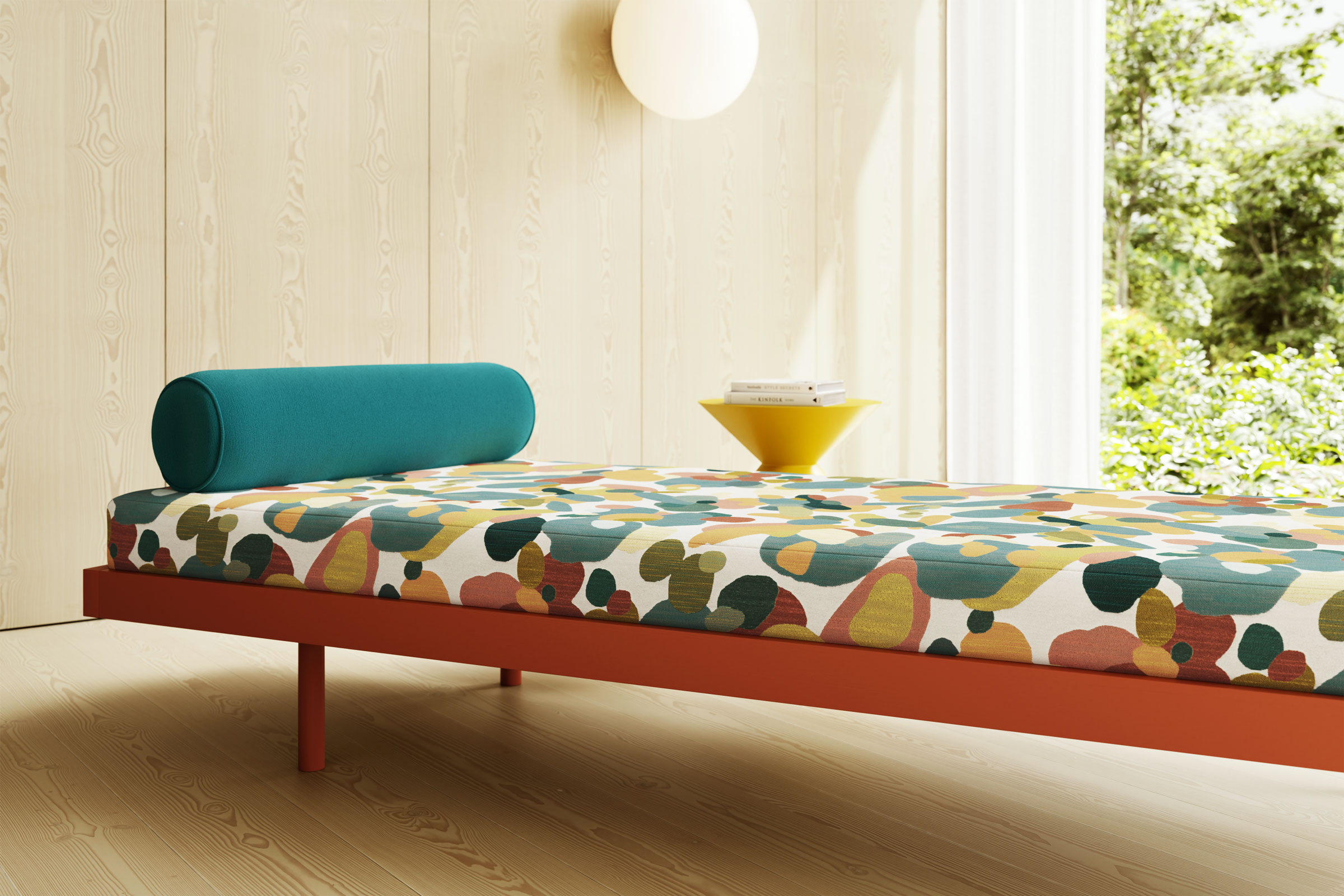Story at a glance:
- Patients and visitors alike say color and art have an impact on their health and well-being, according to experts at Cleveland Clinic.
- Designtex’s new Joy Collection, launched in summer 2024, offers eight vibrant patterns—all Red List–free designs.
- Cleveland Clinic emphasizes a commitment to art with around 7,000 works of fine art in its collection and 45 site-specific commissions.
Thoughtful design stands out not only in residential and hospitality spaces, but in the health care sector, too. Whimsical color, abundant texture, and biophilic design principles can all boost mood and promote overall well-being, according to Sara Balderi, executive director of design at Designtex, a leader in the design of applied materials for the built environment.
Designtex has been focused on balancing beauty, utility, and sustainability while developing textile products for health care environments for more than 35 years. Recently they’ve moved to a more research-based approach in an effort to better understand patient and caregiver needs in these spaces.
Designtex launched its Joy Collection in summer 2024, capturing all the vibrancy and possibility you can imagine in eight patterns designed for virtually any environment while meeting the rigorous performance requirements of the health care industry. Designs are Red List–free and meet requirements for the LEED v4.1 Materials and Resources Credit, among other sustainable attributes.
We know materials play a critical role in aiding in this experience of space.
Designtex works closely with an internal R&D department as well as manufacturing partners. “It’s a collaborative, iterative push-pull of what we’re looking for and what’s possible in the field when it comes to high-performance textiles,” Balderi says.
“The coated textiles in the Joy Collection are 100% silicone, a material known for its exceptional performance and sustainability attributes,” Balderi says. “The woven textiles bring performance at the fiber level with no added finishes because we’re getting the performance through the yarns themselves. Across the collection they are bleach treatable, cleanable, and you can apply disinfectants to all of them.”
In developing the Joy Collection the team learned more about how materials can be experienced through the senses. “We’re always picking up signals around us. Imagine walking into a patient room—what do you notice first? If you’re in an older room, maybe sterile white walls, the beeping of machines, and fluorescent lighting. Conversely, what if you walked in a space where you noticed a soothing pattern on the wall, soft or natural elements like wood, or a sleeper sofa? Is there access to natural lighting?” Balderi says. “Part of our first impression is material driven. We know materials play a critical role in aiding in this experience of space.”
Understanding Neuroaesthetics
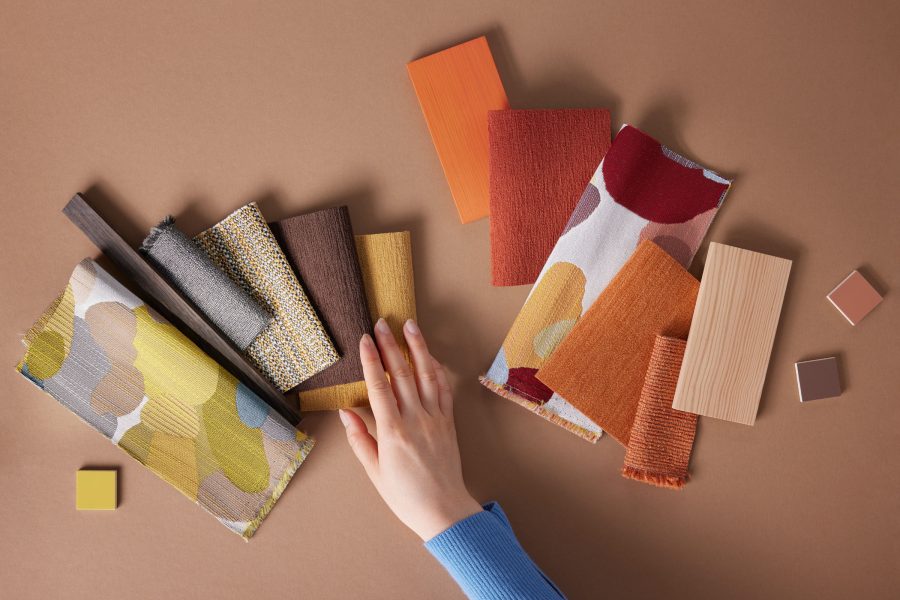
Photo courtesy of Designtex
Research into neuroaesthetics—the study of the aesthetic experience of art, music, or any object that can conjure aesthetic judgments—drove Designtex’s Joy Collection as it aimed to stimulate the brain’s pleasure centers and evoke feelings of happiness.
“We made design interventions that support the research—like organic forms and an abundance of patterns that bring a more joyful, inviting, and uplifting atmosphere,” Balderi says. “We looked at color psychology, visual harmony, attention to detail, and all these things we learned from neuroaesthetics and applied them to every step in the design process.”
Biophilic principles guided the designs, including the color selections. A biophilic color palette is more than earthy greens, browns, and terra-cotta, Balderi says; it’s the pinks and blues of the sky and the purples of flowers, too. “I think we are innately inspired and tuned into nature because it was our first home,” she says. “Research proves when you immerse yourself in nature there is an immediate restorative sensation, and it lessens anxiety.”
Art in Health Care
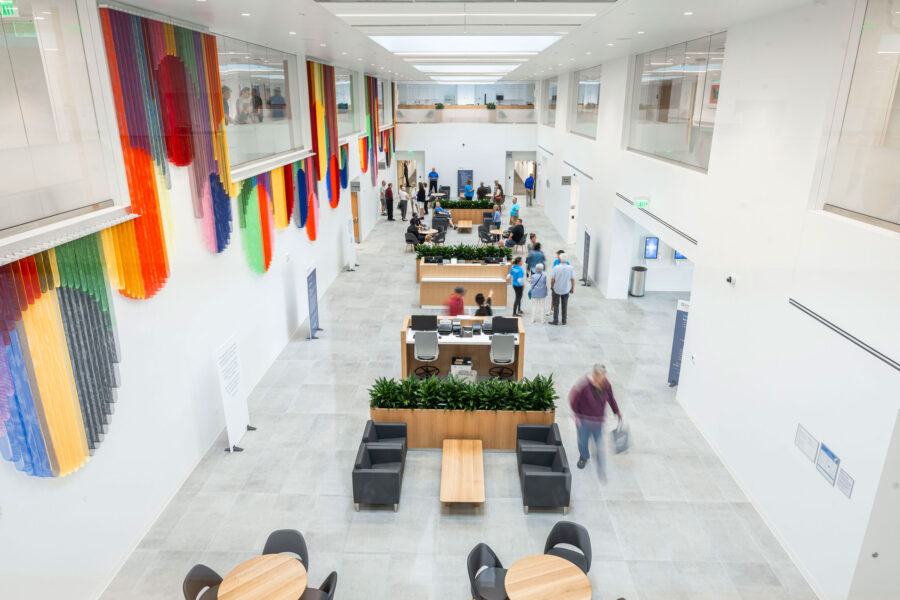
The Cleveland Clinic’s Mentor Hospital makes great use of skylights and vibrant art. Photo courtesy of Cleveland Clinic
“Variety is really important. People really appreciate that things are not generic, and diversity of imagery and colors really makes spaces feel human,” says Ellen Rudolph, curator and senior director of the Cleveland Clinic Art Collection. “That’s feedback we get from patients and visitors. They articulate it in different ways, but the message is that the artwork makes them feel human and that they’re being seen as individuals.”
Rudolph has worked at Cleveland Clinic for more than five years and been in the art world for more than 25. Making the move to health care opened up a world of potential. “It’s a really incredible setting to curate art,” she says, citing the sheer volume of people who come through the clinic annually—more than 13 million patient visits in 2023 alone. “Having the opportunity to touch so many people is really incredible.”
A 2017 study of how patients experience and use art in hospitals showed art contributes to creating an environment and atmosphere where patients can feel safe, socialize, and maintain a connection to the world outside the hospital and support their identity.
The in-house Cleveland Clinic art program started in 2007, led by previous CEO and President Dr. Toby Cosgrove and his idea that white walls and modern spaces could provide a canvas for contemporary art that activated spaces. It was then that an in-house team was created to start a museum-quality collection for Cleveland Clinic to install in public spaces, atriums, and main corridors. The program has spread throughout the Cleveland Clinic enterprise, from Northeast Ohio to Florida to Las Vegas, Toronto, London, and even Abu Dhabi.
Cleveland Clinic has around 7,000 works of fine art in its collection and about 45 site-specific commissions. They also have a program in which anytime they purchase a piece of fine art they request permission to reproduce it as a poster. This helps extend the collection’s reach and allows for more variety of poster imagery. Rudolph estimates they have more than 30,000 posters.
“In the health care environment I think artwork affects people a little differently than it does maybe in a museum setting,” Rudolph says. “Often people are in a state of heightened anxiety, or they have a lot of time to pass; to be able to provide artwork that can help alleviate some of that anxiety, to help people feel less alone or offer a kind of escape or respite is an enormous privilege.”
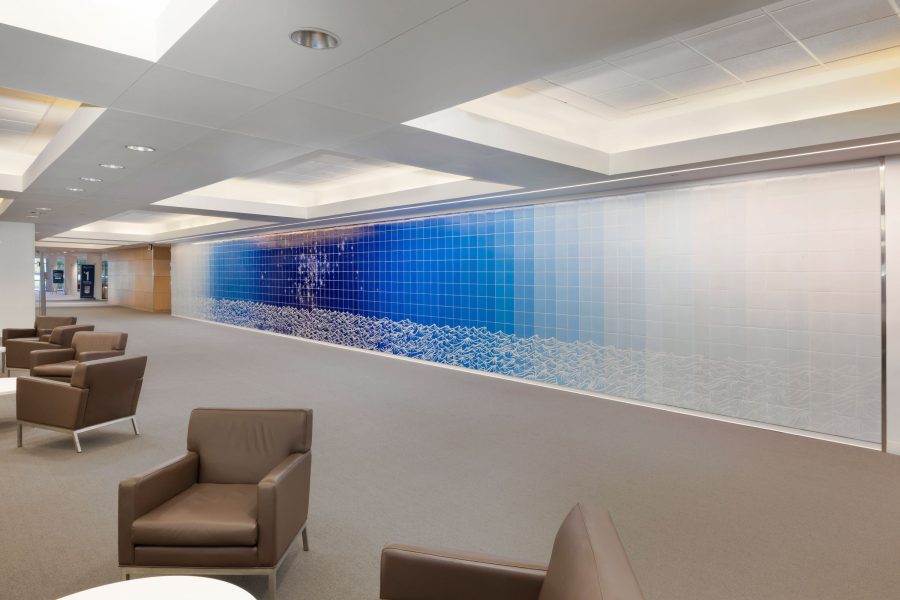
Sandra Cinto’s “Open Landscape” on printed ceramic tiles was commissioned by Cleveland Clinic for Weston Hospital. Photo courtesy of the artist, Tanya Bonakdar, and Miami in Focus
In fall 2024 the team was working to finalize a large installation at an expansion of the Cole Eye Institute, with plans to unveil in early 2025. “We commissioned an artist to do a piece that is going to be suspended from the ceiling. We have quite a few site-specific commissions throughout the health care system. Those projects begin really at the design phase of the building.”
When Cleveland Clinic Mentor Hospital opened in July 2023, it also included a statement piece. The work by artist Eva LeWitt—known for producing vibrant sculptures using commercial and industrial pliable materials that she casts, dyes, cuts, and arranges into colorful, hanging geometric forms—runs much of the length of the hospital lobby. “It’s a great example of an artwork that transforms the whole space,” Rudolph says, noting that the work appears differently depending on your angle.
“In the hospital environment it’s really nice to have different textures people can see and respond to, things that are very tactile, because in clinical environments everything has to be cleanable. That’s built into the design,” she says. “But in some of the nonclinical spaces of the hospital we can place things that have different textures and materiality. It’s really important to be able to offer those moments where there is something to excite your eye and mind.”
In areas where people may have to sit a long time, like an infusion center, she says they strive to offer imagery that people can get lost in and find calming.
Today Cleveland Clinic is looking at ways to further innovate with art. How can they customize patients’ experience in their rooms, for example? “Could we offer them different digital artworks they choose from on screens?”
The Benefits of Beauty in Design
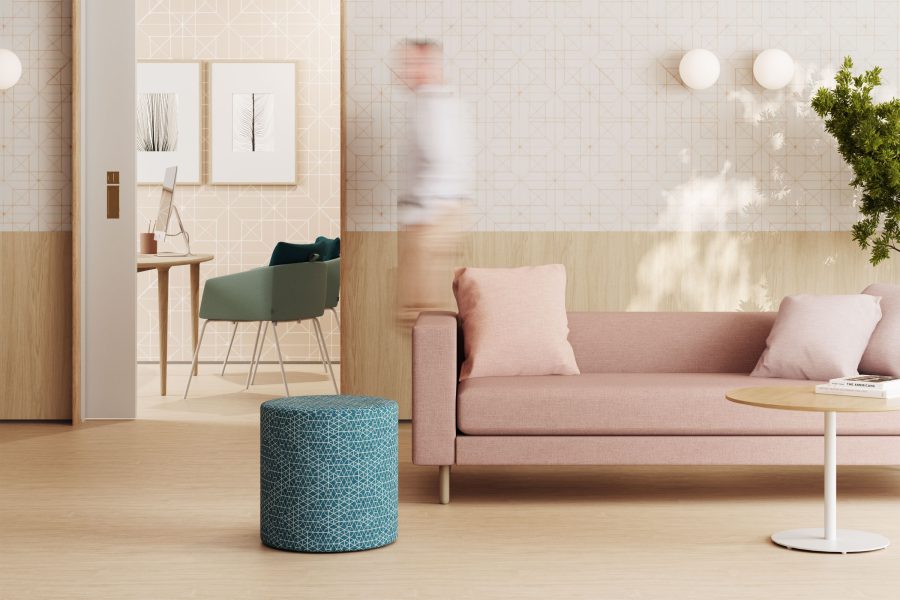
Photo courtesy of Designtex
Designtex also continues to innovate, taking findings from their internal R&D department and product team as well as what they learn from manufacturing partners and building on the experience of materials. “We’re constantly looking at how they perform, their material health, and iterating on that to bring less chemistry to products,” Balderi says. “We’ve introduced water-based polyurethanes with no solvents in them; we have the largest range of solid color 100% silicones; and all of our coated fabrics are GREENGUARD-certified.”
Designtex materials are developed not only to stand up to harsh environments but to maintain high performance. “Now things don’t even need a topcoat; you’re getting performance from the material itself, like silicones,” she says. The company is also looking at how the boundaries of bio-based materials can be pushed. “Can you have something that performs well but also is from a renewable resource?”
Designtex’s commitment to design for well-being continues to show up in ways that attribute to the increased health and happiness of patients, caregivers, and anyone who interacts with their materials. Their approach to shapes, colors, textures, and materials remains deeply rooted in the principles of biophilia. “Materials, colors, patterns—they can all influence the feeling of a space,” Balderi says. “If we can continue to iterate we have a real opportunity to make a difference in the experiences of these spaces. Everyone wants to feel good in the space they’re in.”
Incorporating biophilic design, such as the Joy Collection, into the built environment can have significant positive psychological and physiological responses, including stress reduction and improvements to mental well-being that enhance the healing qualities of health care environments, according to Balderi.
She says the science of neuroaesthetics also taught the design team that spending 20 minutes a day doing something creative can be hugely beneficial to health and happiness. In particular she continues to be excited about Designtex’s Digital Studio, which launched in 2023, as it allows for even more creative freedom. New patterns are continually added to the Digital Studio library—the latest inspired by the meditative practice of drawing and natural phenomena like rainfall, dappled light, meteors, and cosmic cycles. Like all Digital Studio patterns, these are available in a variety of scales, color palettes, and substrates, giving professionals the chance to make exactly what they need.
Designers can also bring a piece of work to Designtex and have it reimagined as a wallcovering or mural. “We’ve collaborated a lot with artists,” Balderi says. “This idea of customization is really interesting and can make the space unique.”
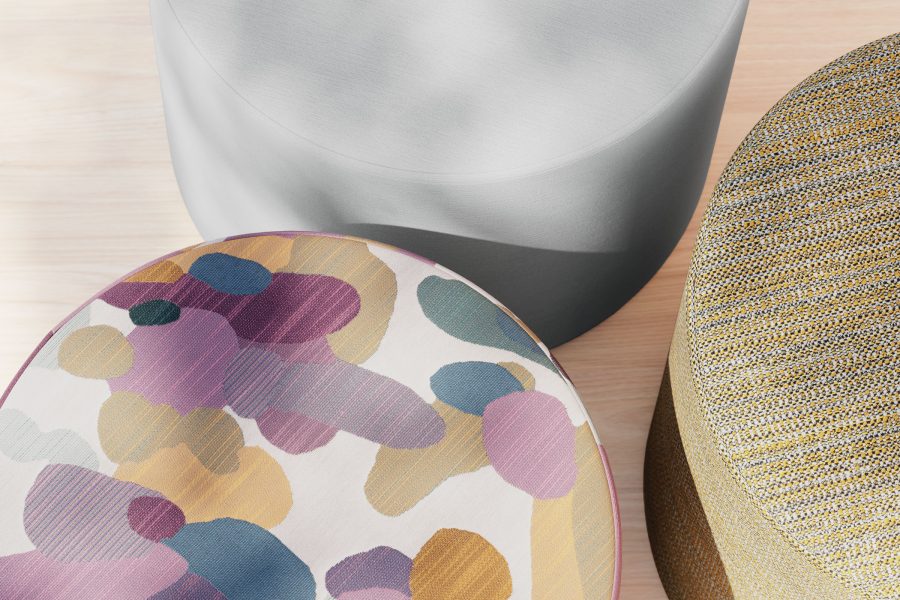
Photo courtesy of Designtex
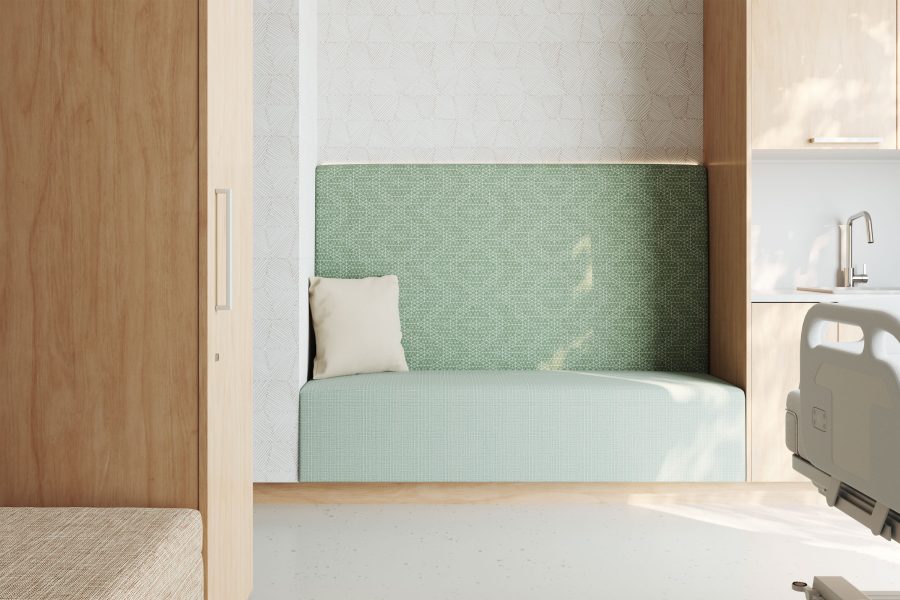
Photo courtesy of Designtex

